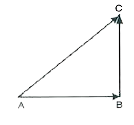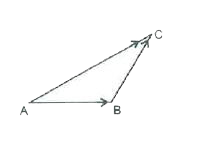If ΔABC~ΔEDFandΔABC is not similar to ΔDEF then which of the following is not ture ?
BC⋅EF=AC⋅FD
AB⋅EF=AC⋅DE
BC⋅DE=AB⋅EF
BC⋅DE=AB⋅FD
The correct Answer is:C
To solve the problem, we need to analyze the relationships between the triangles ABC, EDF, and DEF based on the information given.
1. Understanding Similarity: We know that triangle ABC is similar to triangle EDF. This means that the corresponding sides of these triangles are proportional. Thus, we can write:
ABED=BCDF=ACEF
2. Understanding Non-Similarity: We are also given that triangle ABC is not similar to triangle DEF. This implies that the sides of triangle ABC are not proportional to the sides of triangle DEF. Therefore, we cannot write:
ABDE≠BCEF≠ACDF
3. Analyzing the Options: We need to determine which statement is not true based on the relationships established. We will check the validity of the statements involving the sides of the triangles.
4. Checking Relationships:
- From the similarity of ABC and EDF, we can derive:
- BC⋅EF=AC⋅DF (True)
- AB⋅EF=AC⋅ED (True)
- BC⋅DE=AB⋅EF (This needs to be checked)
5. Identifying the False Statement:
- The statement BC⋅DE=AB⋅EF suggests a relationship that does not hold true because we established that ABC is not similar to DEF. Therefore, the sides of ABC do not maintain the proportionality with the sides of DEF.
- Since BC⋅DE does not equal AB⋅EF, this statement is not true.
Conclusion:
The statement that is not true is:
- BC⋅DE=AB⋅EF
Final Answer:
The answer is option C.
ABED=BCDF=ACEF
ABDE≠BCEF≠ACDF
- From the similarity of ABC and EDF, we can derive:
- BC⋅EF=AC⋅DF (True)
- AB⋅EF=AC⋅ED (True)
- BC⋅DE=AB⋅EF (This needs to be checked)
- The statement BC⋅DE=AB⋅EF suggests a relationship that does not hold true because we established that ABC is not similar to DEF. Therefore, the sides of ABC do not maintain the proportionality with the sides of DEF.
- Since BC⋅DE does not equal AB⋅EF, this statement is not true.
The statement that is not true is:
- BC⋅DE=AB⋅EF
The answer is option C.
Topper's Solved these Questions
- TRIANGLESBook:RS AGGARWALChapter:TRIANGLESExercise:MULTPILE-CHOICE QUESTIONS (MCQ) ( MATCHING OF COLUMNS)
Explore 1 Video
- TRIANGLESBook:RS AGGARWALChapter:TRIANGLESExercise:Test Yourself
Explore 20 Videos
- TRIANGLESBook:RS AGGARWALChapter:TRIANGLESExercise:Exercise 7E
Explore 30 Videos
- T-RATIOS OF SOME PARTICULAR ANGLESBook:RS AGGARWALChapter:T-RATIOS OF SOME PARTICULAR ANGLESExercise:Exercise 11
Explore 27 Videos
- TRIGONOMETRIC IDENTITIESBook:RS AGGARWALChapter:TRIGONOMETRIC IDENTITIESExercise:Test Yourself
Explore 20 Videos
Similar Questions
Knowledge Check
In ΔABC, which of the following is not true ?
 A−−→AB+−−→BC+−−→CA=→0B−−→AB+−−→BC−−−→AC=→0C−−→AB+−−→BC−−−→CA=→0D−−→AB−−−→CB+−−→CA=→0
A−−→AB+−−→BC+−−→CA=→0B−−→AB+−−→BC−−−→AC=→0C−−→AB+−−→BC−−−→CA=→0D−−→AB−−−→CB+−−→CA=→0In triangle ABC, which of the following is not true :
 A−−→AB+−−→BC+−−→CA=→0B−−→AB+−−→BC−−−→AC=→0C−−→AB+−−→BC−−−→CA=→0D−−→AB−−−→CB+−−→CA=→0
A−−→AB+−−→BC+−−→CA=→0B−−→AB+−−→BC−−−→AC=→0C−−→AB+−−→BC−−−→CA=→0D−−→AB−−−→CB+−−→CA=→0In ΔABC, which of the followinhg statemnts are ture
Amaximum valur of sin2A+sin2B+sin2C is same as the maximum valur of sinA+sinB+sinCBR≥2r, where R is circumradius and r is inradiusCR2≥abc(a+b+c)DΔABC is right angled if r+2R,=s, where s is semiperimter
Which of the following is true in a triangle ABC
View SolutionIf for ΔABCandΔDEF , the correspondence CAB↔EDF gives a congruence then which of the following is not true ?
View SolutionIf for ΔABC and <DEF the correspondence CAB↔EDF gives a congruence, then which of the following is not true?
View SolutionΔABC is similar to ΔDEF. The ratio of their perimeters is 4 :1 The ratio of their areas is
View SolutionIf ΔABCandΔDEF are so related the ABFD=BCDE=CAEF, then which of the following is true?
View Solution

